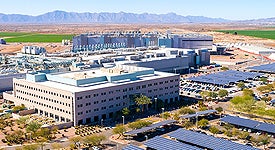Chandler City Code requires that Food Service Establishments (FSEs) that prepare and/or package food or beverages for sale or consumption to install a fats, oils, and grease (FOG) treatment device.
The number of fixtures draining to the FOG treatment devices influences the size and capacity of the device. Have your plumber provide a fixture count and a plumbing plan to City of Chandler’s Development Services when applying for the plumbing permit. It is often more cost effective in the long run to correctly size, design, and install a FOG treatment device according the International Plumbing Code adopted by Chandler City Code, Ch. 29-4 and in accordance to City of Chandler Gravity Grease Interceptor Sizing. The long-term maintenance costs will out-weigh the minor savings of installing a smaller FOG treatment device that will require more frequent cleanings. Additionally, according to International Plumbing Code, 2018 edition, under section 1003.3.2, a food waste disposer / grinder cannot discharge to a FOG treatment device.
The owner of the FOG treatment device assumes the costs associated with cleaning and any maintenance or repairs to the devices. You may choose to clean your own FOG treatment device; however, most people do not attempt this more than once. Even the smallest FOG treatment device contains at least 25 gallons of the most putrid smelling liquid waste imaginable. Liquid waste cannot be placed in the trash and must be disposed of properly. A pumper can quickly and efficiently clean your FOG treatment device, properly transport, and dispose of the waste with minimal disruption to your business.
In addition, the pumper will be able to correctly document the maintenance of your FOG treatment device. The frequency of the cleaning of a FOG treatment device is dependent on the device’s size and capacity and the practices of your staff will have the biggest impact to the cleaning interval. As a rule of thumb, the combined volume of both FOG material and solids inside the treatment device should not exceed 25% of its total capacity. If FOG material is witnessed leaving a treatment device, the cleaning frequency must be increase.
All FOG treatment device records and documentation pertaining to the pumping, cleaning, maintenance, and repairs should be retained onsite for 3 years. The records must include at a minimum the following items:
- The date of service;
- Servicer identity (name and address of a Maricopa County Environmental Service Department licensed non-hazardous liquid waste hauler; or employee name and title if self-serviced);
- Nature of service performed (pumped, repaired, inspected, replaced baffle, etc.)
- Total quantity of material removed; and
- Other information such as final disposal location for the material removed from the interceptor including the name, address, date, and quantity received.
Chandler City Code, Ch. 51-24 prohibits the introduction of chemicals and other additives (enzymes and bacterial products) directly to a FOG treatment device to reduce or eliminate the cleaning or pumping of a treatment device. These enzyme, bacterial, or chemical systems emulsify the FOG material temporarily until it can just re-congeal further down the pipe, generally in the POTW. If such a system is discovered in a facility, it will be required to be removed immediately at owner’s expense. Citations and fines may result.



